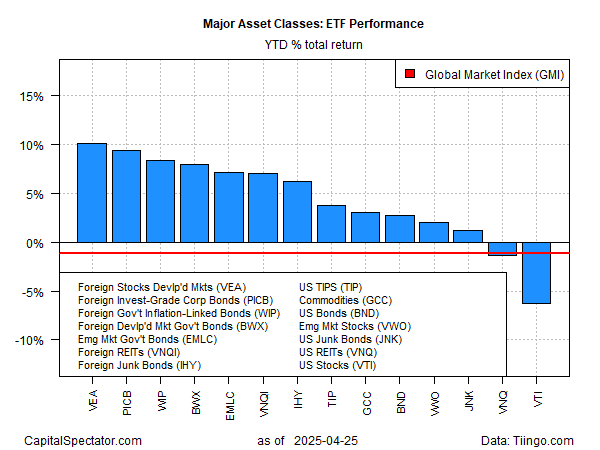Gold ticks up but remains pressured by Fed rate caution, easing trade fears
In a turbulent year for financial markets, US equities and real estate investment trusts are still bearing the brunt of the selling so far in 2025, based on a set of ETFs through Friday’s close (Apr. 25). By contrast, the rest of the major asset classes are still posting gains year to date.
A broad measure of American shares has lost 6.3% so far this year, based on Vanguard Total (EPA:TTEF) US Stock Market ETF (NYSE:VTI). The second-worst performer in 2025: Vanguard Real Estate Index Fund ETF (NYSE:VNQ), which holds US-listed real estate investment trusts and is down 1.3%. The rest of the major asset classes are posting year-to-date gains.

The Global Market Index (GMI), an unmanaged benchmark that holds all the major asset classes in market-value weights, is off 1.1% this year.
The top-performing asset class: stocks in developed markets ex-US (VEA). This slice of global equities is up 10.2% so far in 2025.
Optimists say that US stocks are now relative bargains after this year’s selling. Bullish catalysts that are on the short list as possible triggers to reignite animal spirits for American shares include earnings reports scheduled for this week and the possibility of trade deals that reduce stress related to tariffs.
“The focus this week will be on how much this tariff stress has hit real-world decision-making,” said ING analysts.
On Sunday, the US Treasury Secretary said “there is a path” with China for tariff negotiations. “The Chinese will see this high tariff level is unsustainable for their business,” noted Scott Bessent.
China, by contrast, claim that the country can weather the trade war, and so Beijing appears to be in no rush to negotiate.
Perhaps a more reliable bright spot for US shares is brewing for this week’s earnings reports, with more than one-third of S&P 500 companies scheduled to report. Beating Wall Street estimates on this front could give stocks a lift, although looking in the rear-view mirror at the moment is stale news as long as tariff risk remains high. As a result, investors will be keenly focused on guidance for the near-term future in terms of how companies plan to weather the trade war.
In terms of numbers published to date, “the S&P 500 is reporting solid results for the first quarter,” according to FactSet. “Although the percentage of S&P 500 companies reporting positive earnings surprises is below recent averages, the magnitude of earnings surprises is above recent averages.”
